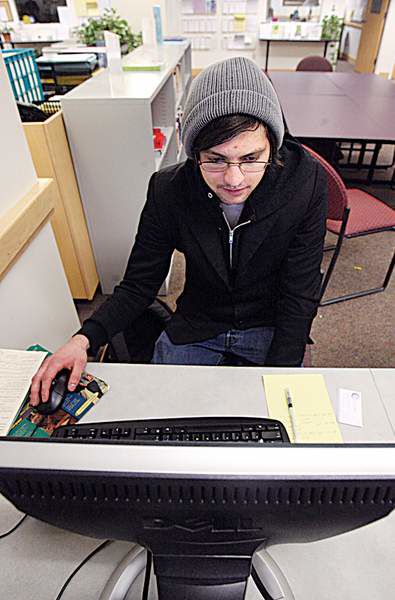COCC halts enrollment for spring
Published 5:00 am Thursday, March 26, 2009

- Adam Shaeffer, 20, searched for available classes at COCC on Wednesday, but the college has cut off new admissions for spring. Shaeffer, who wants to study graphic design, said he hadn’t found any available seats in the classes he wanted.
Central Oregon Community College has bad news for new students still considering enrolling in spring-term classes: There’s no more room.
As of 5 p.m. Wednesday, COCC was no longer registering students for spring-term classes because high enrollment has meant most of those students would be unable to get into the classes they want or need.
Trending
This is the first time COCC has limited admissions, College Relations Director Ron Paradis said. As of Wednesday, he said, more than 5,000 students were registered in classes, and 2,000 of those were also on at least one waiting list. And there were 366 students who, unable to get into any classes, were registered entirely on waiting lists.
Alicia Moore, COCC’s dean of student and enrollment services, said the cutoff does not constitute an enrollment cap. “We’re just saying at this point that the majority of our classes are full, and we have 150 to 200 people scheduled to be advised in the next two days,” she said. “We cannot accommodate more than that. It’s not a cap; we’re just stopping now so we don’t mislead students interested in taking classes.”
“Instead,” Moore continued, “we’ll direct them to summer and fall classes so they can start planning now.”
On Wednesday, Adam Shaeffer, 20, was searching for available classes at COCC’s CAP Center, which offers career, academic and personal counseling.
Shaeffer said he’d like to pursue studies in graphic design, but as he paged through the art, graphic design and general education classes he wanted to take, they all had waiting lists.
“It’s kind of not going very well,” he said, laughing. “Some of the waiting lists have just as many people on it as can be in the class.”
Trending
He’s not sure he wants to wait until summer to take classes. Shaeffer’s looking for work, and said he may try to go somewhere else to study.
“I don’t know if I should pay the application fee,” he said, noting that advisers had told him Wednesday of the college’s plans to limit enrollment. “I told them I wish I’d known before. But it’s my fault.”
In the past, the college has allowed students to register through the first week of the term. Classes begin Monday.
In the fall, 5,400 students signed up to take classes at the college, and 5,739 enrolled for winter courses. Over the past two years, there has been a 29 percent growth in the fall term and a 47 percent growth in the winter for full-time equivalency, which reflects the number of classes students are taking.
Moore said the spring-term head count will not be higher than it was in winter term, but it could reach the same level, which is rare.
Normally, community colleges see their largest enrollment in the fall, and then winter and spring enrollments are smaller. This year, that’s not the case.
“To have such unprecedented enrollment gains in the spring term is beyond anything we could plan for,” Moore said. “We did our best to accommodate this.”
Andrea Henderson, executive director of the Oregon Community College Association, said no other community colleges in Oregon are cutting off enrollment. Sometimes, she said, schools limit the number of students who can enroll in certain programs. But limiting enrollment, she said, is much rarer.
“Generally as community colleges, because we have open access, it’s a first-come, first-served situation,” she said.
To deal with the steep enrollment growth, COCC opened four new classrooms this year, and with Oregon stimulus funding, it expects to add another four by fall. The college also expanded offerings online and at its Redmond campus.
And for students who are shut out for the spring term, the college plans to add more classes this summer. COCC will also seek a $41 million bond in November to build a health and science building, as well as other facilities.
While no other Oregon community college is currently limiting enrollment, Henderson expects that to happen soon. Statewide, community colleges have seen a 12.3 percent increase from winter term last year to this year.
“In the last recession the Legislature drastically cut community college funding, and we dropped about 70,000 students in a two-year period,” she said. “Statewide, we dropped about 4,000 course sections, and tuition went up.”
Henderson said any loss of funding, combined with the huge jump in enrollment at the community college level, will likely lead to limits on student enrollment.
The Legislature has not released its budget for the 2009-11 biennium, but college administrators are worried their state funding will be reduced, making it more difficult to add full-time faculty members.
“It is certainly our hope that we don’t have to do something like this in the future, and that the addition of classes and appropriate support staff will allow us to serve all students wishing to pursue a career path,” Moore said. “This is really heartbreaking to me to do something along those lines because it’s against the community college mission. But we’re out of space and we’re out of staff.”
For now, Moore said, the growth seems to be spread across programs at the college, though there is a slightly larger demand for career and technical education programs. She said she’d also noticed that the percentage of students who are 31 to 40 years old is up as well.
“We think that’s truly reflective of the local economy,” she said.
David Douglas, 21, wants to study wildland fire science. On Wednesday, the La Pine resident waited in the CAP Center to take a placement test. He said he wasn’t very hopeful he’d get into the classes he wanted.
“My roommates go here and all their classes have huge wait lists,” Douglas said. “I’m pretty sure that’s going to happen to me.”
Douglas fights fires in the summertime, so if he can’t get into the classes he wants this spring, he’s going to have to wait.
“It’s probably good that it’s first-come, first-serve,” he said. “I’ll come back in the fall.”








